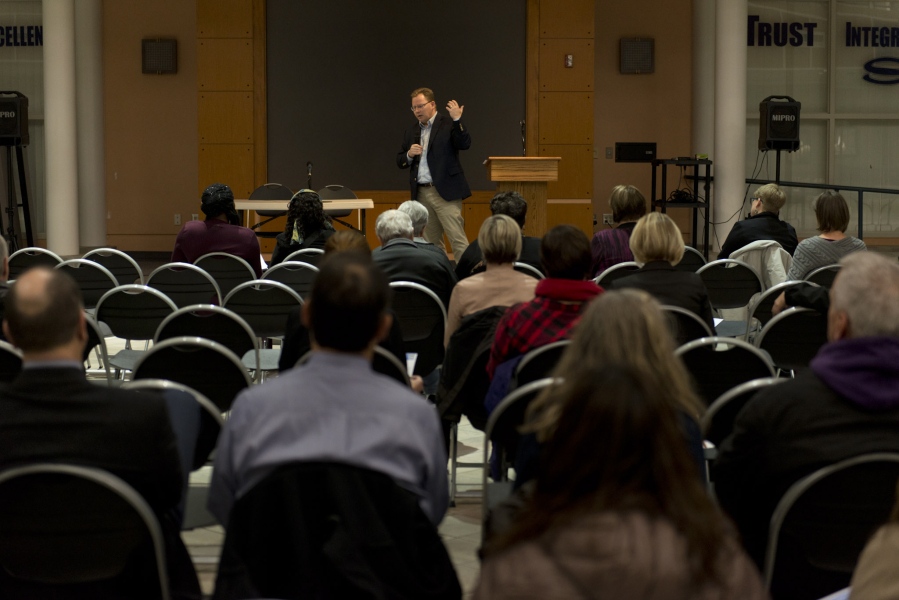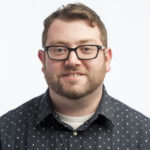Washington State Superintendent of Public Instruction Chris Reykdal made a stop in Vancouver on Wednesday night to hold a community forum on the future of education in the state, but first he had to talk about the very recent past.
Specifically, Reykdal spent some of his time at Skyview High School talking about this past summer, when Clark County was a hotbed of intense negotiations between school districts and teachers unions. Districts around the state were negotiating new contracts and/or salary schedules thanks to the McCleary legislation, which last year saw the state pour $7.3 billion in new funding for schools to be spread over four years, followed by another $1 billion this year for teacher salaries.
Reykdal said half of the strikes around the state this summer happened here in Clark County.
“We could’ve helped in that better,” Reykdal said of the Office of Superintendent of Public Instruction.
He said his office could’ve provided earlier analysis on the numbers and what the influx of money meant, which could’ve helped clear up some confusion.
However, Reykdal spent much of the forum talking about the McCleary money as a step to improving education in the state as opposed to a singular solution. He said that when the Legislature starts back up, he wants to continue to expand the basic education that is funded by the state and help bring more capital funding to school projects.
He said school capital budgets are “significantly underfunded in the state.” Reykdal said the emphasis would start in more rural areas of the state, where districts can’t drum up 60 percent approval to pass a bond issue.
Another part of McCleary that Reykdal wants to see changed is the cap on what districts can ask for in local levies. While the McCleary money is designed to help fund basic education, limiting the amount districts can ask for from the public is limiting flexibility, he said. Districts can use levy money for a variety of programs, whether to help low-income students or provide more for special education students or students with disabilities.
He would like to see districts and communities have the option of using more levy dollars, should voters want to, Reykdal said.
The Columbian’s Katie Gillespie moderated the forum, and asked Reykdal about state representatives being weary of talking education again after it took years to get a McCleary decision, something that was brought up by Rep. Monica Stonier, D-Vancouver, at a recent Washington State Board of Education meeting. Reykdal said it’s his job to “be a pest” and push for improvements in education.
“I’m still here,” he said. “The kids are still here.”
He also said education can be improved with money spent to improve communities, such as helping with the opioid epidemic and mental health issues.
“It doesn’t all have to come in K through 12,” he said.
Diversity
Another topic brought up during Reykdal’s presentation and in multiple questions from the roughly 50-plus attendees Wednesday night was diversity. Reykdal said schools can become a welcoming place for a wider range of students partly through professional development, and looking at things like rewriting discipline rules, pushing students equally and attracting a more diverse workforce.
He said that 11 percent of teachers in the state are teachers of color. However, for teachers with five years or less experience, that number increases to 16 percent. Reykdal said higher education programs need to do a better job recruiting from a more diverse talent pool, and there needs to be more mentorship and support for teachers of color to retain them in the profession. Reykdal said that while McCleary helped raise starting salaries, something like a loan forgiveness program could help draw a more diverse workforce into teaching.
One of the fastest ways to attract more teachers of color is through dual language programs, something Reykdal’s office also wants to push for.
“It’s one of the best ways to create a global citizen,” he said.
Reykdal called dual language programs a “justice issue, cultural issue and big economic issue.” In dual language programs, students spend part of their day learning in English and part of their day learning in another language. Woodland Primary School started an English-Spanish dual language program for kindergarten students this year.
Students in dual language programs become global thinkers and have more professional options worldwide, Reykdal said. That’s also one of the problems in recruiting teachers for a dual language program.
“There are better opportunities as bilingual speakers than teaching,” he said.
He would like to see some incentives for school districts which hire bilingual teachers, such as bonuses for teachers with bilingual certifications. That would drive up interest in those programs, and make higher education programs offer more of them, Reykdal said.




